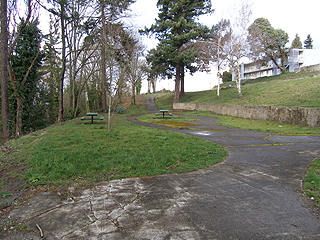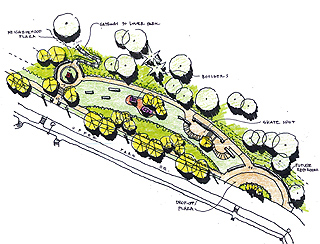
Surveys
DJC.COM
April 5, 2007
Park design gets a boost from street skaters
GGLO

Images courtesy of GGLO Metro Parks Tacoma is planning a renovation of McKinley Park with input from skateboarders. |
What constitutes a traditional park? A broad lawn and shrubbery? A field with play equipment? A plaza with water features and places to sit? A community P-patch? It can be any or all of these things. Parks, whatever their program, provide valuable outdoor space, and the key to successful park design lies in understanding and engaging its users.
Though it is easy to think of a park in terms of families and young children, these are likely not the primary group enjoying the facilities. As communities and trends change, parks need to keep pace. How can designers, park departments, and others make parks flexible and responsive to these demands?
As users and needs change so must traditional approaches to park design. A significant and historically ignored group is street skaters. New studies illustrate the design needs, opportunities and influence of this once disenfranchised group.
The traditional solution to providing skateable spaces in parks has been to set aside a dedicated space for a “skate park” and fence it. But many street skaters prefer urban terrain, features that were not designed for skateboarding. These street skaters will actually avoid skateparks in favor of walls, railings, steps and plazas.
A recent American Sports Data survey indicates there are 10.6 million skateboarders nationwide and that Seattle ranks sixth in the number of people who skate. That translates to about 30,000 skaters in the Seattle area.
Serving the needs of this user group does not necessarily mean creating skateparks with large concrete bowl features and transitional surfaces. This group is diverse and so are the skating opportunities they seek. These new needs are reflected in the evolution of design solutions and new terms: “skate dots” are small singular skateable elements that can be integrated into the streetscape or park design; and “skate spots” are larger-scale facilities that serve a dozen or so and are often dedicated to one skill level.
GGLO’s practice is focused primarily on the urban realm, creating opportunities for passive and active recreation within built environments. Whether we are designing parks or urban plazas, we are ever cognizant of the needs of urban users. Street skaters, with their unique affinity for urban terrain, have captured our imagination.
A case study

One of the concepts for McKinley Park integrates a skate spot with other park features.
|
We are assisting Metro Parks Tacoma in the full-scale renovation of McKinley Park, a historic 27-acre park located in east Tacoma. Metro Parks has adopted the view that skateboarding is a desirable and essential activity within its city parks.
“Skate dots are a great concept that evolved directly from conversations with skaters,” said Park Board President Tim Reid. “Visually, they are more appealing than traditional skate parks. They also help create activity throughout the park, rather than congregating uses in limited areas. And from the skater’s viewpoint, we understand that they provide diverse challenges which really appeal to them.”
As Metro Parks takes a comprehensive look at the future of its park system, it has committed to providing a range of skateboarding facilities throughout the community.
At the same time, local skateboarding advocacy groups such as Tacoma Skateparks are educating the business community and general public about the benefits of skateboarding. In addition, these groups worked actively to raise money to supplement public funds available for skateboard facilities. This teamwork has encouraged some non-traditional thinking about parks and skateboarding facilities.
Metro Parks and the skateboarding community have asked for a park with a nontraditional approach, a park that can be skated. With their input, our designs will incorporate not only play equipment, climbing rocks, benches, etc., but also skateable features throughout the park.
Design strategies
Here are some key considerations and strategies for creating skateable parks from our ongoing work at McKinley Park.
1. Educate the public
There are common misconceptions about skateboarding and skateboarders. Many often associate skateboarding with vandalism, drug use and other community problems. In early community meetings for McKinley Park, some neighbors included skateboarding with drug dealing and prostitution as common park problems.
In many parks, skatestoppers (the shiny metal cleats attached to walls and steps to prevent skating) are more common than trees. These devices are denying frequent visitors use of the facilities.
The Tacoma skateboarding community includes a broad and diverse range of participants, from grade school kids just learning to professionals who skate with their own kids.
Many of those who expressed early opposition to skating near their homes have adjusted their views based on meeting with and learning more about the local skateboarding community. Without education and public meetings, these misconceptions can lead to public opposition to skateable features in parks.
2. Active spaces
To design “typical” park features to be skateable, their organization and distribution within the park must be carefully considered. As common sense would avoid routing a walkway through a basketball court or placing a tot lot adjacent to ball fields, these skateable features require similar consideration to minimize or avoid conflicts between park activities.
Each skateable feature has a clear zone that provides adequate space for a skater to build up speed and room to avoid running into other skaters or park users. Clear zones must be considered in all the spaces that are considered skateable.
Of course, there will be areas where skating needs to be discouraged. Instead of using skatestoppers or other unsightly devices, other techniques and materials are equally successful. For example, concrete paving attracts skaters but crushed rock or aggregate paving and stone steps do not.
Park circulation and user separation is fundamental to successful skate integration. Where Olmstead designed underpasses for carriages in Central Park, today’s parks need a clear separation of walkers, bikers and skaters. This assures enjoyment and peace of mind for all.
3. Skaters know this stuff
Skaters are often the best resource to understand and design a successful skateable space. Throughout the McKinley Park design process, the skateboarding community has had an active voice in the design.
“What we anticipate will make the skate dot concept successful,” said the Park Board’s Reid, “is that skaters were so actively engaged in the design process, alongside community members who enjoy the park for other uses. That is critical to developing parks that can be actively used, and simultaneously enjoyed, by people who have different reasons for coming to the park.”
For McKinley, we asked skaters to go out into the community and take photos, make sketches and describe their favorite public skating features. These urban elements can then be integrated into the park’s design. Understanding the popularity of particular elements helps to define the maximum density of users and frequency of skateable features, as well as providing tips for preventing skating in non-skateable areas.
4. It’s in the details
There are no accepted standards for street-skating facilities. Therefore, many design choices require active participation with the skateboarding community. They can be an indispensable resource in providing information about what works and what doesn’t, including construction details and materials. Simple choices such as concrete finish, spacing of control joints, and edge radii can make or break a skateable space. For McKinley, the Tacoma skateboarding community has been a crucial resource.
At historic McKinley Park, where the neighborhood’s open space has aged, skaters serve a key role in revitalizing and reclaiming this community amenity. They are vocal advocates and fund-raisers actively engaged in improving the park. They are athletes and users who can provide a unique constituency for the park that enhances activity and delights spectators. They are stewards with an abiding interest in helping to maintain their hard-won right to participate in the space.
The goal is to provide an active, engaging recreational space, and skate features are important elements in the designer’s toolbox. GGLO is focused on integrating skate users and skateable elements into many of our park designs. We encourage other designers to do the same.
Brian Bishop, a landscape designer with GGLO, is the project manager on McKinley Park. Kent Scott, ASLA, is the principal who leads the firm’s Landscape Group.
Other Stories:
- Celebrate National Landscape Architecture Month
- Add value to your team with a landscape architect
- Making freeways more than just pavement
- Designing playgrounds for the next generation
- UW team transforms garbage into gardens
- How landscaping is greening up Seattle
Copyright ©2009 Seattle Daily Journal and DJC.COM.
Comments? Questions? Contact us.